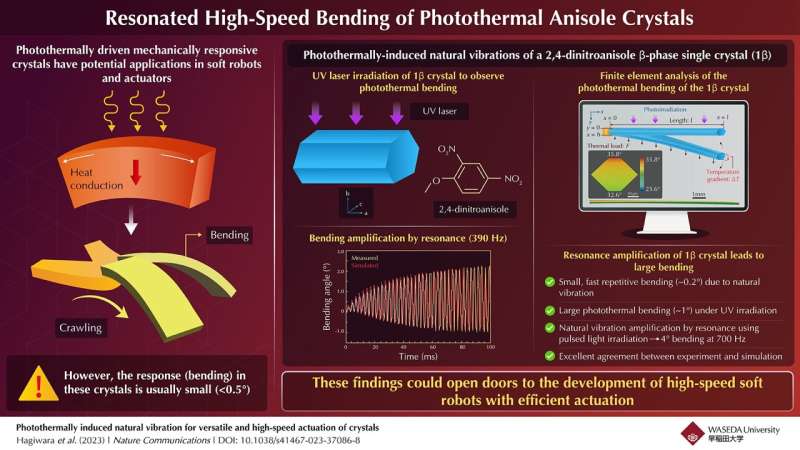This article has been reviewed according to Science X's editorial process and policies. Editors have highlighted the following attributes while ensuring the content's credibility:
fact-checked
peer-reviewed publication
trusted source
proofread
Versatile, high-speed, and efficient crystal actuation with photothermally resonated natural vibrations

Every material possesses a unique natural vibration frequency such that when an external periodic force is applied to this material close to this frequency, the vibrations are greatly amplified. In the parlance of physics, this phenomenon is known as "resonance." Resonance is ubiquitous in our daily life, and, depending on the context, could be deemed desirable or undesirable.
For instance, musical instruments like the guitar relies on resonance for sound amplification. On the other hand, buildings and bridges are more likely to collapse under an earthquake if the ground vibration frequency matches their natural frequency.
Interestingly, natural vibration has not received much attention in material actuation, which relies on the action of mechanically responsive crystals. Versatile actuation technologies are highly desirable in the field of soft robotics. Although crystal actuation based on processes like photoisomerisation and phase transitions have been widely studied, these processes lack versatility since they require specific crystals to work.
One way to improve versatility is by employing photothermal crystals, which show bending due to light-induced heating. While promising for achieving high-speed actuation, the bending angle is usually small (<0.5°), making the actuation inefficient.
Now, a team of scientists from Waseda University and Tokyo Institute of Technology in Japan has managed to overcome this drawback with nothing more than the age-old phenomenon of resonated natural vibration. The team, led by Dr. Hideko Koshima from Waseda University in Japan, used 2,4-dinitroanisole β-phase crystals (1β) to demonstrate large-angle photothermally resonated high-speed bending induced by pulsed UV irradiation.
Their research was published in Nature Communications and made available online on March 13, 2023. "Initially, the goal of this research was to create crystals that bend largely due to the photothermal effect. Therefore, we chose 2,4-dinitroanisole (1) β-phase crystal (1β), which has a large thermal expansion coefficient," explains Koshima, speaking of the team's motivation behind the study.
"We serendipitously discovered fast and small natural vibration induced by the photothermal effect. Furthermore, we achieved high-speed and large bending by photothermally resonating the natural vibration."
In their work, the team first cooled a methanol solution of commercially available anisole 1 to obtain hexagonal, rod-shaped 1β single crystals. To irradiate them with UV light, they used a pulsed UV laser with a wavelength of 375 nm and observed the bending response of the crystal using a digital high-speed microscope.
They found that the rod-shaped 1β crystals showed, under UV irradiation, a fast natural vibration at 390 Hz with a large photothermal bending of nearly 1°, which is larger than the value of 0.2° previously reported in other crystals.
Further, the bending angle due to the natural vibration increased to nearly 4° when irradiated with pulsed UV light at 390 Hz (same as the crystal's natural frequency). In addition to this large bending, the team observed a high response frequency of 700 Hz along with the highest energy conversion efficiency recorded till date.
These findings were further confirmed through simulations performed by the team. To their excitement, the simulation results showed excellent agreement with experimental data. "Our findings show that any light-absorbing crystal can exhibit high-speed, versatile actuation through resonated natural vibrations. This can open doors to the applications of photothermal crystals, leading eventually to real-life soft robots with high-speed actuation capability and perhaps a society with humans and robots living in harmony," concludes Koshima.
More information: Yuki Hagiwara et al, Photothermally induced natural vibration for versatile and high-speed actuation of crystals, Nature Communications (2023). DOI: 10.1038/s41467-023-37086-8
Journal information: Nature Communications
Provided by Waseda University




















